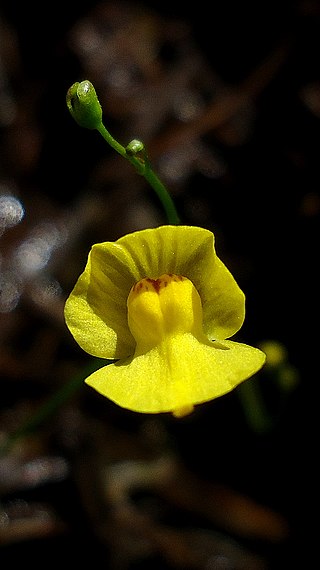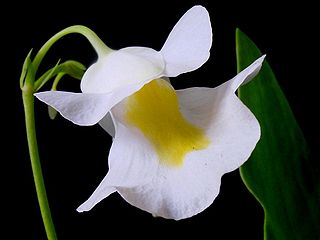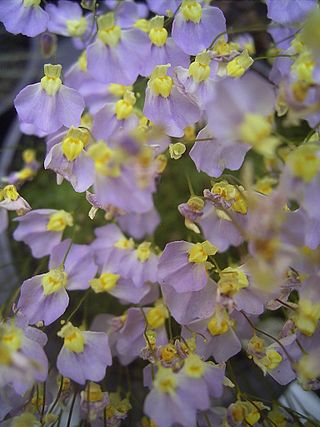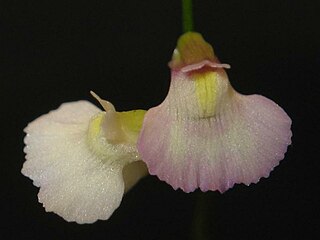
Utricularia, commonly and collectively called the bladderworts, is a genus of carnivorous plants consisting of approximately 233 species. They occur in fresh water and wet soil as terrestrial or aquatic species across every continent except Antarctica. Utricularia are cultivated for their flowers, which are often compared with those of snapdragons and orchids, especially amongst carnivorous plant enthusiasts.

Genlisea is a genus of carnivorous plants also known as corkscrew plants. The 30 or so species grow in wet terrestrial to semi-aquatic environments distributed throughout Africa and Central and South America. The plants use highly modified underground leaves to attract, trap and digest minute microfauna, particularly protozoans. Although suggested a century earlier by Charles Darwin, carnivory in the genus was not proven until 1998.

Pinguicula moranensis is a perennial rosette-forming insectivorous herb in the flowering plant family Lentibulariaceae. It is native to El Salvador, Guatemala, Honduras and Mexico. A species of butterwort, it forms summer rosettes of flat, succulent leaves up to 10 centimeters (4 in) long, which are covered in mucilaginous (sticky) glands that attract, trap, and digest arthropod prey. Nutrients derived from the prey are used to supplement the nutrient-poor substrate that the plant grows in. In the winter the plant forms a non-carnivorous rosette of small, fleshy leaves that conserves energy while food and moisture supplies are low. Single pink, purple, or violet flowers appear twice a year on upright stalks up to 25 centimeters long.

Utricularia gibba, commonly known as the humped bladderwort or floating bladderwort, is a small, mat-forming species of carnivorous aquatic bladderwort. It is found on all continents except Antarctica.

Utricularia inflata, commonly known as the swollen bladderwort, inflated bladderwort, or large floating bladderwort, is a large suspended aquatic carnivorous plant that belongs to the genus Utricularia. It is a perennial that is native to the southeastern coastal plains of the United States. It has often been confused with U. radiata, which is similar but smaller than U. inflata. Since 1980, U. inflata has been reported to exist in locations beyond its traditional range, such as the Adirondack Mountains in New York, southeastern Massachusetts, and in Washington State. Studies on the populations in the Adirondacks suggest that an introduction of U. inflata to a location where it naturalizes can lead to altered sediment chemistry by reducing the net primary productivity of native species. It is also listed by the state of Washington as a problematic species because of the dense mat-forming habit of this aquatic Utricularia. It is one of the few carnivorous plants that can be invasive.

Utricularia calycifida is a small to medium-sized terrestrial perennial carnivorous plant that belongs to the genus Utricularia. U. calycifida is endemic to northern South America and can be found in Brazil, Guyana, Suriname, and Venezuela.

Utricularia sect. Orchidioides is a section in the genus Utricularia. The species in this section are small or medium-sized terrestrial or epiphytic carnivorous plants native to Central and South America. Alphonse Pyrame de Candolle originally published this section in 1844. In 1916, John Hendley Barnhart moved the section to its own genus, Orchyllium, recognizing that the species in this section are distinct. Several other botanists, including Henry Gleason, considered the treatment of these species in the genus Orchyllium valid and moved other species from Utricularia to Orchyllium. Ultimately the species were all reunited under Utricularia.

Utricularia asplundii is a small to medium-sized terrestrial or epiphytic, perennial carnivorous plant that belongs to the genus Utricularia. U. asplundii is endemic to western South America and is found in Colombia and Ecuador. It was originally published and described by Peter Taylor in 1975. Specimens cited by Alvaro Fernández-Pérez in 1964 from Colombia as U. jamesoniana were partly U. jamesoniana and partly U. asplundii.
Utricularia geminiloba is a medium-sized perennial lithophyte or terrestrial carnivorous plant that belongs to the genus Utricularia. U. geminiloba is endemic to Brazil. It was originally published and described by Ludwig Benjamin in 1847. The species epithet refers to the two pronounced anterior corolla lobes.

Utricularia jamesoniana is a small perennial epiphyte carnivorous plant in the family Lentibulariaceae. It is native to Central America, the Antilles, and northern and western South America. Specifically, it can be found in Bolivia, Brazil, Colombia, Costa Rica, Ecuador, French Guiana, Guatemala, Guyana, Nicaragua, Panama, Peru, Suriname, and Venezuela and on the islands of Guadeloupe, Hispaniola, Dominica, and Martinique. The species was originally published and described by Daniel Oliver in 1860. Its habitat is reported as being mossy tree trunks in montane cloud forests or lowland rain forests at altitudes from sea level to 2,500 m (8,202 ft). It flowers year-round.
Utricularia geoffrayi is a small, probably perennial, terrestrial carnivorous plant that belongs to the genus Utricularia. U. geoffrayi is native to Indochina and can be found in Cambodia, Thailand, and Vietnam. It was originally published and described by François Pellegrin in 1920. It grows as a terrestrial plant among short grasses in or around rice fields at altitudes from sea level to 1,300 m (4,265 ft). It has been collected in flower between September and December.
Utricularia rigida is a small to medium-sized perennial, rheophytic carnivorous plant that belongs to the genus Utricularia. U. rigida is endemic to western tropical Africa, where it can be found in Côte d'Ivoire, Guinea, Guinea-Bissau, Mali, Nigeria, Senegal, and Sierra Leone. It grows as a rheophyte on inclined rock faces in swiftly running water at altitudes from near sea level to 1,250 m (4,101 ft). It was originally described and published by Ludwig Benjamin in 1847. It is distinguished from the other species in the section, U. tetraloba, by having only two lower lip corolla lobes as opposed to U. tetraloba's four.
Utricularia tetraloba is a very small, probably perennial, rheophytic carnivorous plant that belongs to the genus Utricularia. U. tetraloba is endemic to Guinea and Sierra Leone. It grows as a rheophyte on rocks in shallow running water at altitudes from 360 m (1,181 ft) to 690 m (2,264 ft). It was originally described and published by Peter Taylor in 1963. It is distinguished from the other species in the section, U. rigida, by having four lower lip corolla lobes as opposed to U. rigida's two.

Utricularia bisquamata is a small annual carnivorous plant that belongs to the genus Utricularia. It is native to southern Africa, where it can be found in Angola, Lesotho, Madagascar, Namibia, and South Africa. U. bisquamata grows as a terrestrial plant in damp, sandy or peaty soils among mosses by streams or wet depressions at altitudes from near sea level to 1,200 m (3,937 ft) in South Africa and up to 2,250 m (7,382 ft) in Angola. It was originally described and published by Franz Paula von Schrank in 1824.
Utricularia macrocheilos is a small annual carnivorous plant that belongs to the genus Utricularia. It is endemic to western tropical Africa, where it is only known from the mountain ranges of Guinea and Sierra Leone. U. macrocheilos grows as a terrestrial plant among wet rocks at medium altitudes. It flowers between August and January. A specimen of U. macrocheilos was originally included in the description of U. prehensilis by François Pellegrin in 1914 and also in John Hutchinson and Nicol Alexander Dalzell's 1931 description of U. micropetala. Peter Taylor recognized these specimens as a different taxon in a 1963 review of African species and treated it as a variety of U. micropetala. After further discussions with other botanists and review of the specimens, he elevated the variety to the species level in 1986 as U. macrocheilos. Compared to U. micropetala, U. macrocheilos has much longer corolla lips and less acute fruiting calyx lobe apices. Taylor notes, however, that the vegetative body of the plants and the seeds appear to be identical.

Carnivorous plants are plants that derive some or most of their nutrients from trapping and consuming animals or protozoans, typically insects and other arthropods. Carnivorous plants still generate some of their energy from photosynthesis. Carnivorous plants have adapted to grow in places where the soil is thin or poor in nutrients, especially nitrogen, such as acidic bogs. They can be found on all continents except Antarctica, as well as many Pacific islands. In 1875, Charles Darwin published Insectivorous Plants, the first treatise to recognize the significance of carnivory in plants, describing years of painstaking research.

Utricularia rostrata is a small annual carnivorous plant that belongs to the genus Utricularia. U. rostrata is endemic to the Chapada Diamantina highlands of Bahia, Brazil. It grows as a terrestrial plant in damp sandy soils near streams and waterfalls in semi-shaded areas at altitudes from 550 to 1,570 metres. It was originally described and published by Andreas Fleischmann and Fernando Rivadavia in 2009, though specimens of this species had been discovered as early as 1992. Fleischmann and Rivadavia note that the species is common throughout the Chapada Diamantina highlands and its distribution includes Chapada Diamantina National Park, thus justifying its ranking as a species of Least Concern under the IUCN.

Pinguicula orchidioides is a perennial rosette-forming insectivorous herb native to Mexico and Guatemala. A species of butterwort, it forms summer rosettes of flat, succulent leaves up to 5 centimeters (2 in) long, which are covered in mucilaginous (sticky) glands that attract, trap, and digest arthropod prey. Nutrients derived from the prey are used to supplement the nutrient-poor substrate that the plant grows in. Uniquely among Pinguicula species from the Americas, p. orchidioides produces gemma-like basal buds which elongate into stolons and serve as a means of asexual reproduction. In the winter the plant forms a non-carnivorous rosette of small, fleshy leaves that conserves energy while food and moisture supplies are low. Single purple flowers appear between July and September on upright stalks up to 22 centimeters long.
Utricularia regia is a carnivorous plant that belongs to the genus Utricularia and is endemic to the Sierra Madre del Sur region of Guerrero, Mexico. It is similar to U. hintonii and U. petersoniae, but it is easily distinguished from these species by the unusual 4-lobed division of the upper corolla lip and the unique color pattern. Utricularia regia is an annual rupicolous species that is found growing among rocks with mosses and Selaginella in pine forests at altitudes from 1,650 m (5,413 ft) to 1,900 m (6,234 ft). It grows during the rainy season and flowers from September to October, producing fruit from October to early November. The specific epithet regia was chosen because of the appearance of an inverted crown in the markings of the lower corolla lip. It was discovered in 2005 and collected again on subsequent botanical explorations in preparation for the Flora de Guerrero. It was formally described in a 2009 volume of Brittonia by Sergio Zamudio and Martha Olvera. The authors placed the new species into Peter Taylor's section Psyllosperma, which has subsequently been merged with section Foliosa based on molecular phylogenetics.












